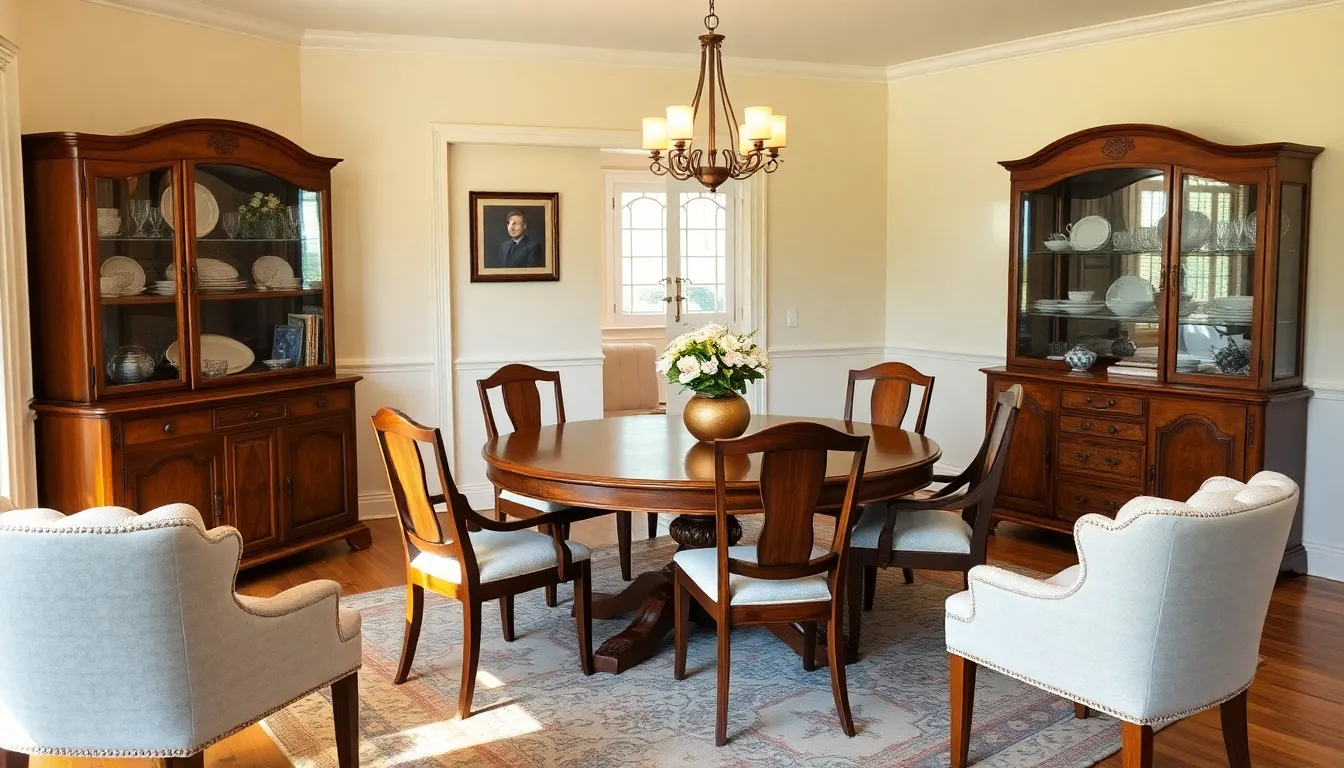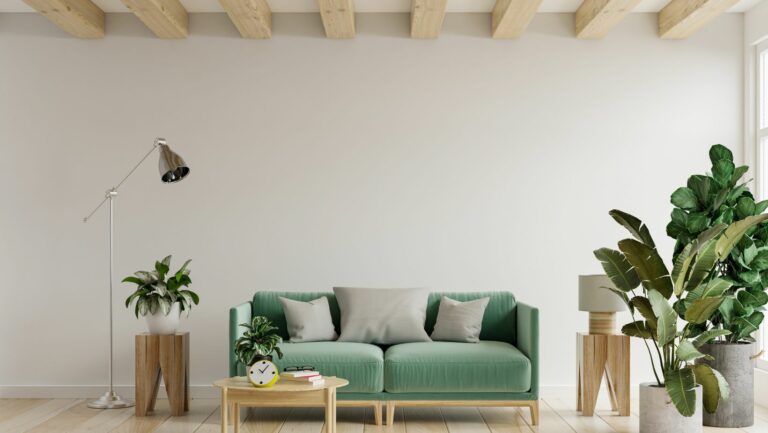The dining room serves as the heart of the home, where families gather to share meals and create lasting memories. Choosing the right dining room furniture can transform this space into a stylish and functional area that reflects personal taste and lifestyle. From elegant tables to comfortable chairs, each piece plays a vital role in setting the tone for dining experiences.
With a myriad of styles, materials, and designs available, selecting the perfect dining room furniture can feel overwhelming. Whether it’s a modern minimalist look or a classic rustic charm, understanding the options helps make informed decisions. This guide explores key factors to consider when furnishing a dining room, ensuring it becomes a welcoming environment for every occasion.
Table of Contents
ToggleOverview of Dining Room Furniture
Dining room furniture plays a crucial role in defining the space’s aesthetics and functionality. Key elements include tables, chairs, storage solutions, and accents that enhance style while providing comfort.
Tables
Dining tables come in various shapes and sizes, accommodating different spaces and preferences. Round tables promote intimate conversations, while rectangular tables cater to larger groups. Common materials include wood, glass, and metal, each offering unique characteristics and durability.
Chairs
Dining chairs vary in design, including upholstered, wooden, and metal options. Comfort and aesthetics should guide selections. Ergonomically designed chairs support extended meals, while stylish designs complement the table and overall decor.
Storage Solutions
Storage options like buffets and sideboards provide practicality and elegance. They offer space for tableware, linens, and other dining essentials. Selecting pieces that match the dining table and chairs creates a cohesive look, enhancing organization and convenience.
Accents
Accent pieces such as centerpieces, placemats, and lighting fixtures enhance the dining experience. These elements add personality and character while contributing to the overall ambiance of the room. Thoughtful choices in accents create a welcoming atmosphere for guests.
In selecting dining room furniture, consider the space’s size, style preferences, and functionality. Each component contributes to a harmonious dining environment, ensuring it meets the needs of families and guests alike.
Types of Dining Room Furniture

Choosing the right types of dining room furniture enhances both functionality and style. Key pieces include tables, chairs, storage units, and display cabinets that contribute to the overall dining experience.
Dining Tables
Dining tables come in various shapes and sizes. Round tables often create a cozy atmosphere, perfect for small gatherings. Rectangular tables accommodate larger groups, making them ideal for family meals or entertaining guests. Square tables provide versatility for smaller spaces, while extendable tables offer flexibility for varying guest counts. Materials range from solid wood to glass, affecting durability and aesthetic appeal.
Dining Chairs
Dining chairs play a crucial role in comfort and style. Chairs vary in design, such as upholstered for added comfort or wooden for a more traditional look. Styles include modern, rustic, and classic, catering to diverse tastes. Height, width, and back support are essential factors for seating comfort. Some chairs feature armrests for added relaxation. Swivel chairs provide mobility, making it easier for guests to engage in conversations.
Buffets and Sideboards
Buffets and sideboards add practical storage solutions to dining rooms. Buffets often have a surface for serving food, paired with storage for dishes, linens, and utensils. Sideboards can serve a similar purpose but are generally narrower, perfect for smaller spaces. Both options come in various styles and finishes, enhancing the room’s decor. These pieces help keep the dining area organized and clutter-free.
China Cabinets
China cabinets are essential for showcasing fine china and decorative items. These cabinets often feature glass doors, allowing guests to admire the contents. Various styles, including traditional and modern, cater to different tastes. They provide ample storage for dishware while adding height and visual interest to the dining room. Many china cabinets include adjustable shelves, accommodating various item sizes.
Key Factors to Consider
Choosing the right dining room furniture involves several key factors that significantly influence both functionality and design. Understanding these elements helps in making an informed selection.
Size and Space
Selecting furniture that fits the available space is crucial. Measure the dining area, including width and length, to determine the optimal table size. Consider the number of chairs needed for comfortable seating, allowing at least 24 inches per person at the table. A balance between furniture scale and room dimensions ensures easy movement and accessibility during meals.
Material and Durability
Material choice directly impacts durability and maintenance. Solid wood, for example, offers durability and a classic aesthetic, while engineered wood provides a budget-friendly alternative and ease of cleaning. Metal and glass options lend a modern look but may require more upkeep. Assessing how often the dining room is used also influences the material decision; high-traffic areas benefit from sturdy, scratch-resistant surfaces.
Style and Aesthetics
The style of the furniture should align with the overall design theme of the home. Traditional styles incorporate ornate details and rich finishes, whereas contemporary styles favor clean lines and minimalism. Ensure that colors and textures of the furniture complement existing decor elements, such as wall colors, flooring, and lighting fixtures. This cohesive appearance enhances the dining room’s appeal, making it a welcoming space for gatherings.
Popular Trends in Dining Room Furniture
Current trends in dining room furniture highlight both contemporary and rustic styles, each offering unique aesthetic and functional attributes. These designs cater to diverse tastes and preferences, enhancing the dining experience.
Contemporary Designs
Contemporary dining room furniture emphasizes clean lines, minimalism, and a focus on functionality. Popular choices include:
- Sleek Tables: Rectangular and round tables featuring smooth finishes and innovative materials like tempered glass and polished metal.
- Modular Seating: Benches and chairs with geometric shapes that allow for flexible arrangements in various spaces.
- Mixed Materials: Combinations of wood, metal, and upholstery for a dynamic look that provides both comfort and durability.
- Bold Accents: Use of vibrant colors or artistic designs in dining chairs, providing a stylish contrast to simpler tables.
These elements create an inviting atmosphere while appealing to modern sensibilities.
Rustic Looks
Rustic dining room furniture embraces warmth and natural elements, creating a cozy environment. Key components include:
- Solid Wood Tables: Chunky, reclaimed wood tables that showcase natural grain patterns, offering durability and charm.
- Farmhouse Chairs: Often featuring ladder backs and cushioned seating, these chairs add character and comfort.
- Textured Fabrics: Use of linen and cotton for chair upholstery, enhancing tactile warmth and inviting guests to linger.
- Vintage Accents: Incorporation of antique or distressed finishes on sideboards and storage pieces that emphasize a timeless feel.
These features promote a welcoming ambiance, perfect for gatherings and family meals.
Buying Tips for Dining Room Furniture
Selecting the right dining room furniture involves careful consideration of various factors. These tips provide a more detailed approach to making informed purchases.
Where to Shop
- Furniture Stores: Visit local and national furniture retailers for a wide selection and the opportunity to test furniture comfort.
- Online Retailers: Utilize websites specializing in home furnishings, which often feature a broader inventory and competitive pricing.
- Antique Shops: Explore vintage and antique shops for unique pieces that add character to the dining room.
- Warehouse Outlets: Check warehouse outlets for discounted prices on brand-name furniture, providing opportunities for substantial savings.
- Custom Furniture Makers: Consider local artisans for bespoke options tailored to specific design preferences or space constraints.
Budget Considerations
- Establish a Budget: Determine an overall budget early to guide selection and avoid overspending.
- Prioritize Essentials: Focus on essential items like tables and chairs first, deferring decorative pieces until later.
- Compare Prices: Research prices across multiple retailers to identify the best deals and value.
- Look for Discounts: Watch for seasonal sales, clearance events, or promotional offers that can significantly reduce costs.
- Consider Quality vs. Quantity: Invest in durable pieces that withstand wear over time instead of opting for cheaper, less durable items.
Selecting the right dining room furniture is essential for creating a space that’s both functional and inviting. By considering factors such as size, material, and style, individuals can find pieces that not only meet their practical needs but also enhance the overall aesthetic of their home.
With a variety of current trends available, from contemporary minimalism to rustic charm, there’s something to suit every taste. Thoughtful choices in furniture can transform the dining area into a warm gathering spot for family and friends, ensuring memorable moments are shared around the table. Investing time in finding the perfect dining room pieces will ultimately lead to a space that reflects personal style while providing comfort and practicality.



